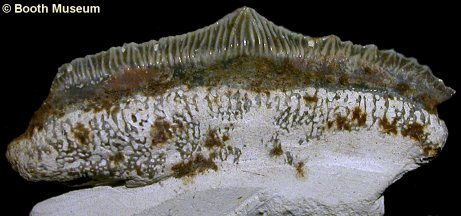
|
HYBODONTOIDEA [Humped-tooth Sharks] |
The now extinct hybodont sharks, which thrived during the Triassic to Early Cretaceous, were a relatively 'primitive' and declining group by the Late Cretaceous. The Chalk shark fauna is dominated by neoselachians, and teeth of hybodonts (Polyacrodus) are only very occasionally recorded from the Grey Chalk, though small associations of teeth are known (see below). Shallower water Late Cretaceous rocks, such as in the American Interior Seaway, contain more hybodonts than the European Chalk.
Teeth are moderately large, low and wide, dominated by a large bar-like root,
taller than the crown. A weakly developed
main cusp
is present at the mid point of the crown, with a further series of very weakly
developed
accessory cusps along the length of the
cutting edge.
A distinct ornament of fine ridges
is present on the crown, with ridges converging at the apex
of the cusps.

1). Polyacrodus illingworthi - Lingual view of a tooth, from a small association of teeth which comprise the type material (x4, Grey Chalk, Southerham, near Lewes, Sussex, Willett Collection, Booth Museum, BMB 007357, by kind permission of John Cooper).

2). Polyacrodus illingworthi; Crown (biting surface) view of teeth, from a small association of teeth which comprise the type material (x4, Grey Chalk, Southerham, near Lewes, Sussex, Willett Collection, Booth Museum, BMB 007357, by kind permission of John Cooper).
3). Polyacrodus illingworthi; Overview of an exceptionally rare association of teeth (x1.5, Grey Chalk, England, NHMUK (British Museum (Natural History) London) PV P43511). Image © 2012 The Natural History Museum, by kind permission.
4). Polyacrodus illingworthi; Detail of an exceptionally rare association of teeth (x4.1, Grey Chalk, England, NHMUK (British Museum (Natural History) London) PV P43511). Image © 2012 The Natural History Museum, by kind permission.